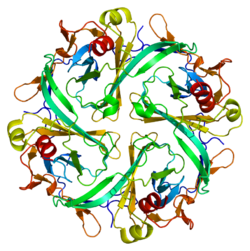TheKir2.1inward-rectifier potassium channelis alipid-gated ion channelencoded by theKCNJ2gene.[5][6][7][8]
Clinical significance
editA defect in this gene is associated withAndersen-Tawil syndrome.[9]
A mutation in the KCNJ2 gene has also been shown to causeshort QT syndrome.[10]
In research
editIn neurogenetics, Kir2.1 is used inDrosophilaresearch to inhibit neurons, as overexpression of this channel willhyperpolarizecells.
In optogenetics, a trafficking sequence from Kir2.1 has been added tohalorhodopsinto improve its membrane localization. The resulting protein eNpHR3.0 is used inoptogenetic researchto inhibit neurons with light.[11]
Expression of Kir2.1 gene in humanHEK293 cellsinduce a transient outward current, creating a steadymembrane potentialclose to thereversal potentialof potassium.[12]
Interactions
editKir2.1 has been shown tointeractwith:
References
edit- ^abcGRCh38: Ensembl release 89: ENSG00000123700–Ensembl,May 2017
- ^abcGRCm38: Ensembl release 89: ENSMUSG00000041695–Ensembl,May 2017
- ^"Human PubMed Reference:".National Center for Biotechnology Information, U.S. National Library of Medicine.
- ^"Mouse PubMed Reference:".National Center for Biotechnology Information, U.S. National Library of Medicine.
- ^Hansen SB (May 2015)."Lipid agonism: The PIP2 paradigm of ligand-gated ion channels".Biochimica et Biophysica Acta (BBA) - Molecular and Cell Biology of Lipids.1851(5): 620–8.doi:10.1016/j.bbalip.2015.01.011.PMC4540326.PMID25633344.
- ^Raab-Graham KF, Radeke CM, Vandenberg CA (1994). "Molecular cloning and expression of a human heart inward rectifier potassium channel".NeuroReport.5(18): 2501–5.doi:10.1097/00001756-199412000-00024.PMID7696590.
- ^Derst C, Karschin C, Wischmeyer E, Hirsch JR, Preisig-Müller R, Rajan S, Engel H, Grzeschik K, Daut J, Karschin A (2001). "Genetic and functional linkage of Kir5.1 and Kir2.1 channel subunits".FEBS Lett.491(3): 305–11.Bibcode:2001FEBSL.491..305D.doi:10.1016/S0014-5793(01)02202-5.PMID11240146.S2CID14452157.
- ^Kubo Y, Adelman JP, Clapham DE, Jan LY, Karschin A, Kurachi Y, Lazdunski M, Nichols CG, Seino S, Vandenberg CA (2005). "International Union of Pharmacology. LIV. Nomenclature and molecular relationships of inwardly rectifying potassium channels".Pharmacol. Rev.57(4): 509–26.doi:10.1124/pr.57.4.11.PMID16382105.S2CID11588492.
- ^Donaldson MR, Yoon G, Fu YH, Ptacek LJ (2004). "Andersen-Tawil syndrome: a model of clinical variability, pleiotropy, and genetic heterogeneity".Ann. Med.36(Suppl 1): 92–7.doi:10.1080/17431380410032490.PMID15176430.S2CID7362563.
- ^Priori SG, Pandit SV, Rivolta I, Berenfeld O, Ronchetti E, Dhamoon A, Napolitano C, Anumonwo J, di Barletta MR, Gudapakkam S, Bosi G, Stramba-Badiale M, Jalife J (April 2005)."A novel form of short QT syndrome (SQT3) is caused by a mutation in the KCNJ2 gene".Circ. Res.96(7): 800–7.doi:10.1161/01.RES.0000162101.76263.8c.PMID15761194.
- ^Gradinaru V, Zhang F, Ramakrishnan C, Mattis J, Prakash R, Diester I, Goshen I, Thompson KR, Deisseroth K (April 2010)."Molecular and cellular approaches for diversifying and extending optogenetics".Cell.141(1): 154–65.doi:10.1016/j.cell.2010.02.037.PMC4160532.PMID20303157.
- ^Zhang DY, Lau CP, Li GR (2009-04-01). "Human Kir2.1 channel carries a transient outward potassium current with inward rectification".Pflügers Archiv: European Journal of Physiology.457(6): 1275–1285.doi:10.1007/s00424-008-0608-0.ISSN1432-2013.PMID19002489.S2CID3120804.
- ^Nehring RB, Wischmeyer E, Döring F, Veh RW, Sheng M, Karschin A (2000)."Neuronal inwardly rectifying K(+) channels differentially couple to PDZ proteins of the PSD-95/SAP90 family".J. Neurosci.20(1): 156–62.doi:10.1523/JNEUROSCI.20-01-00156.2000.PMC6774109.PMID10627592.
- ^Kurschner C, Yuzaki M (1999)."Neuronal interleukin-16 (NIL-16): a dual function PDZ domain protein".J. Neurosci.19(18): 7770–80.doi:10.1523/JNEUROSCI.19-18-07770.1999.PMC6782450.PMID10479680.
- ^Grishin A, Li H, Levitan ES, Zaks-Makhina E (2006)."Identification of gamma-aminobutyric acid receptor-interacting factor 1 (TRAK2) as a trafficking factor for the K+ channel Kir2.1".J. Biol. Chem.281(40): 30104–11.doi:10.1074/jbc.M602439200.PMID16895905.
Further reading
edit- Kubo Y, Adelman JP, Clapham DE, et al. (2006). "International Union of Pharmacology. LIV. Nomenclature and molecular relationships of inwardly rectifying potassium channels".Pharmacol. Rev.57(4): 509–26.doi:10.1124/pr.57.4.11.PMID16382105.S2CID11588492.
- Wood LS, Tsai TD, Lee KS, Vogeli G (1995). "Cloning and functional expression of a human gene, hIRK1, encoding the heart inward rectifier K+-channel".Gene.163(2): 313–7.doi:10.1016/0378-1119(95)00244-Z.PMID7590287.
- Kubo Y, Baldwin TJ, Jan YN, Jan LY (1993). "Primary structure and functional expression of a mouse inward rectifier potassium channel".Nature.362(6416): 127–33.Bibcode:1993Natur.362..127K.doi:10.1038/362127a0.PMID7680768.S2CID4243856.
- Raab-Graham KF, Radeke CM, Vandenberg CA (1995). "Molecular cloning and expression of a human heart inward rectifier potassium channel".NeuroReport.5(18): 2501–5.doi:10.1097/00001756-199412000-00024.PMID7696590.
- Ashen MD, O'Rourke B, Kluge KA, et al. (1995). "Inward rectifier K+ channel from human heart and brain: cloning and stable expression in a human cell line".Am. J. Physiol.268(1 Pt 2): H506–11.doi:10.1152/ajpheart.1995.268.1.H506.PMID7840300.
- Tang W, Qin CL, Yang XC (1996). "Cloning, localization, and functional expression of a human brain inward rectifier potassium channel (hIRK1)".Recept. Channels.3(3): 175–83.PMID8821791.
- Tare M, Prestwich SA, Gordienko DV, et al. (1998)."Inwardly rectifying whole cell potassium current in human blood eosinophils".J. Physiol.506(2): 303–18.doi:10.1111/j.1469-7793.1998.303bw.x.PMC2230727.PMID9490857.
- Rae JL, Shepard AR (1998). "Inwardly rectifying potassium channels in lens epithelium are from the IRK1 (Kir 2.1) family".Exp. Eye Res.66(3): 347–59.doi:10.1006/exer.1997.0432.PMID9533862.
- Kurschner C, Yuzaki M (1999)."Neuronal interleukin-16 (NIL-16): a dual function PDZ domain protein".J. Neurosci.19(18): 7770–80.doi:10.1523/JNEUROSCI.19-18-07770.1999.PMC6782450.PMID10479680.
- Tucker SJ, Ashcroft FM (1999)."Mapping of the physical interaction between the intracellular domains of an inwardly rectifying potassium channel, Kir6.2".J. Biol. Chem.274(47): 33393–7.doi:10.1074/jbc.274.47.33393.PMID10559219.
- Nehring RB, Wischmeyer E, Döring F, et al. (2000)."Neuronal inwardly rectifying K(+) channels differentially couple to PDZ proteins of the PSD-95/SAP90 family".J. Neurosci.20(1): 156–62.doi:10.1523/JNEUROSCI.20-01-00156.2000.PMC6774109.PMID10627592.
- Leonoudakis D, Mailliard W, Wingerd K, et al. (2001)."Inward rectifier potassium channel Kir2.2 is associated with synapse-associated protein SAP97".J. Cell Sci.114(Pt 5): 987–98.doi:10.1242/jcs.114.5.987.PMID11181181.
- Derst C, Karschin C, Wischmeyer E, et al. (2001). "Genetic and functional linkage of Kir5.1 and Kir2.1 channel subunits".FEBS Lett.491(3): 305–11.Bibcode:2001FEBSL.491..305D.doi:10.1016/S0014-5793(01)02202-5.PMID11240146.S2CID14452157.
- Stockklausner C, Ludwig J, Ruppersberg JP, Klöcker N (2001)."A sequence motif responsible for ER export and surface expression of Kir2.0 inward rectifier K(+) channels".FEBS Lett.493(2–3): 129–33.Bibcode:2001FEBSL.493..129S.doi:10.1016/S0014-5793(01)02286-4.PMID11287009.S2CID19230587.
- Dart C, Leyland ML (2001)."Targeting of an A kinase-anchoring protein, AKAP79, to an inwardly rectifying potassium channel, Kir2.1".J. Biol. Chem.276(23): 20499–505.doi:10.1074/jbc.M101425200.PMID11287423.
- Plaster NM, Tawil R, Tristani-Firouzi M, et al. (2001)."Mutations in Kir2.1 cause the developmental and episodic electrical phenotypes of Andersen's syndrome".Cell.105(4): 511–9.doi:10.1016/S0092-8674(01)00342-7.PMID11371347.S2CID17015195.
- Jeong JS, Lee HJ, Jung JS, et al. (2001). "Characterization of inwardly rectifying K(+) conductance across the basolateral membrane of rat tracheal epithelia".Biochem. Biophys. Res. Commun.288(4): 914–20.doi:10.1006/bbrc.2001.5831.PMID11688996.
- Giovannardi S, Forlani G, Balestrini M, et al. (2002)."Modulation of the inward rectifier potassium channel IRK1 by the Ras signaling pathway".J. Biol. Chem.277(14): 12158–63.doi:10.1074/jbc.M110466200.PMID11809752.
- Preisig-Müller R, Schlichthörl G, Goerge T, et al. (2002)."Heteromerization of Kir2.x potassium channels contributes to the phenotype of Andersen's syndrome".Proc. Natl. Acad. Sci. U.S.A.99(11): 7774–9.Bibcode:2002PNAS...99.7774P.doi:10.1073/pnas.102609499.PMC124349.PMID12032359.
- Ai T, Fujiwara Y, Tsuji K, et al. (2002)."Novel KCNJ2 mutation in familial periodic paralysis with ventricular dysrhythmia".Circulation.105(22): 2592–4.doi:10.1161/01.CIR.0000019906.35135.A3.PMID12045162.
External links
edit- GeneReviews/NCBI/NIH/UW entry on Andersen-Tawil syndrome
- OMIM entries on Anderson-Tawil syndrome
- KCNJ2+protein,+humanat the U.S. National Library of MedicineMedical Subject Headings(MeSH)
- Kir2.1+channelat the U.S. National Library of MedicineMedical Subject Headings(MeSH)





